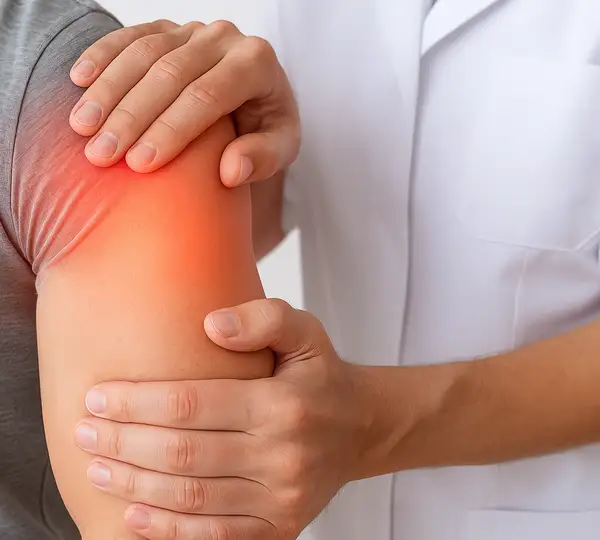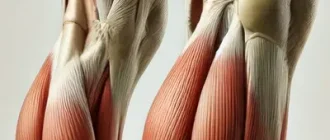When clinicians measure ROM that reflects both active and passive movement, they’re tracking patterns seen in millions of physical therapy sessions each year. Studies show that reduced joint mobility becomes more common with age, injury, or prolonged inactivity, making ROM testing a vital part of rehabilitation and recovery. These evaluations provide a clear picture of how well the body’s mechanics are functioning.
In daily life, after exercise, injury, or even long periods of sitting, many people notice subtle limits — moments when a joint moves easily on its own, or only when assisted — echoing that same active-versus-passive motion gap. Exploring why these differences appear helps uncover causes, guide treatment, and restore comfort and mobility.
Active ROM: When Muscles Take the Lead
Active ROM refers to joint movements initiated entirely by the patient’s own muscles without external help. This type of motion tests both muscle strength and coordination. For instance, raising your arm overhead or bending your knee after a jog are examples of active ROM.
Physical therapists often recommend active ROM for individuals recovering from mild sprains, strains, or early-stage joint stiffness. It improves circulation, prevents muscle atrophy, and enhances neuromuscular coordination. However, performing these movements incorrectly may cause overcompensation or minor joint irritation.
A 2024 survey from the American Physical Therapy Association found that 74% of therapists prefer active ROM as a first-line recovery technique ⧉. According to Reyus Mammadli, medical consultant, active ROM should always start with low-resistance, pain-free exercises, such as heel slides or finger flexions, to encourage safe mobility restoration.
Passive ROM: Letting the Therapist Do the Work
Passive ROM occurs when another person or device moves the patient’s joint without muscle engagement from the patient. It’s essential for patients recovering from surgery, paralysis, or severe trauma. During this process, the therapist gently moves the joint through its normal range to maintain flexibility and prevent contractures.
This technique is common in post-operative rehabilitation, such as following rotator cuff repair or knee replacement. In advanced clinics, robotic systems like Continuous Passive Motion (CPM) machines assist movement 24/7 for enhanced recovery precision. Studies show that passive ROM helps maintain joint nutrition and circulation, even when active movement isn’t possible ⧉.
However, overuse of passive ROM can reduce the patient’s own muscle activation. According to Mammadli, passive therapy should be temporary and always integrated with gradual active movement to rebuild neuromuscular control.
Diagnostic Evaluation: Measuring ROM Accurately
ROM assessment is critical in diagnosing joint conditions, tracking recovery, and setting rehab goals. Below are the three most common diagnostic methods used in clinical practice today.
| Method | Accuracy (1–10) | Average Cost (U.S.) |
|---|---|---|
| Manual Goniometer | 6 | $30–$100 |
| Digital Goniometer | 8 | $150–$400 |
| 3D Motion Capture | 10 | $1,000+ per session |
Manual Goniometer
The manual goniometer is the simplest and most traditional tool used in physical therapy and orthopedic practice. It consists of two plastic or metal arms with a central protractor that measures the joint’s angle. The therapist aligns the arms with the bones adjacent to the joint, records the angle, and compares it to standard reference values.
This method requires no special preparation and takes just a few minutes. However, accuracy can vary depending on the practitioner’s experience. It’s ideal for basic assessments during regular therapy visits.
Digital Goniometer
Digital goniometers operate similarly but use electronic sensors to capture angles with improved precision. The device automatically calculates and stores the data, allowing for easier tracking of progress over time. Some models, such as JTECH Commander Echo or Baseline Digital, also connect to mobile apps for real-time feedback.
The process usually takes about 10–15 minutes and is completely noninvasive. No patient preparation is needed, though consistent positioning across sessions is important for reliable results.
3D Motion Capture
This advanced method employs infrared cameras or wearable motion sensors to create a three-dimensional map of joint movement. Systems like Biodex System 4 Pro, Kinetisense, or Vicon Motion Analysis record each phase of movement with near-laboratory precision. Results are generated instantly, with detailed visual reports.
Patients should wear tight-fitting clothing to ensure sensors detect movement accurately. This technology is especially beneficial for athletes, post-surgical patients, and individuals requiring in-depth biomechanical analysis. Its high cost is justified by exceptional diagnostic value and precision.
These diagnostic methods allow clinicians to tailor rehabilitation programs, track measurable improvement, and identify even subtle motion deficits. The evaluation typically lasts 30–45 minutes, guiding customized therapy plans based on objective data.
Treatment and Rehabilitation Approaches
Physical Therapy Programs
Modern rehab programs combine active and passive ROM to maximize flexibility and muscle re-education. Sessions may include guided stretching, proprioceptive training, and robotic-assisted exercises. Popular technologies include Biodex Isokinetic Systems and CPM machines for knee and shoulder rehab.
In the U.S., one physical therapy session averages $90–$150 per hour, while a full course (10–12 weeks) can reach $1,500–$3,000 ⧉.
Medications and Pain Management
Pain control is vital to maintaining patient compliance. Non-steroidal anti-inflammatory drugs (NSAIDs) such as ibuprofen (Advil) and naproxen (Aleve) are commonly prescribed. Muscle relaxants like methocarbamol (Robaxin) help reduce spasms during early recovery phases.
Topical agents including Voltaren Gel (diclofenac 1%) can be used to target joint inflammation locally. However, Mammadli emphasizes that pharmacologic treatment should never replace mechanical movement in restoring ROM.
Surgical and Postoperative Support
After procedures like arthroplasty or ligament reconstruction, passive ROM begins within 24–48 hours using CPM devices. The machines gently flex and extend the joint to prevent stiffness. Research indicates that consistent use of CPM can shorten rehab time by up to 20% ⧉.
Robotic rehab systems, such as Hocoma Lokomat and MyoCycle Pro, also allow precise control over movement amplitude and speed, promoting early motor relearning.
Real Clinical Cases from the U.S.
Case 1: Male, 45, Texas — Recovery After ACL Reconstruction
After a skiing accident in Colorado, this 45-year-old software engineer underwent ACL reconstruction surgery. The first two weeks post-surgery were dedicated solely to passive ROM using a CPM machine, set to gently flex the knee from 0° to 45° several times per hour. This prevented joint stiffness and improved circulation.
At week three, his therapist introduced active-assisted exercises, such as heel slides and quad sets, progressing gradually to independent active ROM by week five. The main challenge? Overcoming the fear of reinjury — something his therapist addressed through progressive confidence-based training.
Within three months, his knee flexion reached 130°, strength improved by 85%, and he was able to return to light jogging. The only minor setback was occasional swelling after overuse, which was managed with ice therapy and compression sleeves.
Case 2: Female, 62, California — Living with Knee Osteoarthritis
This retired teacher from Los Angeles had been battling chronic knee pain for over a decade. After years of conservative management, she opted for a non-surgical rehabilitation plan focused on passive and gentle active ROM exercises.
Her sessions involved therapist-guided movements combined with water-based therapy to reduce joint pressure. The routine started with passive flexion-extension exercises, later incorporating seated leg raises and mini squats. Within six weeks, her pain score dropped from 7/10 to 4/10, and swelling visibly decreased.
Emotionally, she described the process as “liberating” — being able to climb stairs again without pain was a milestone. While complete restoration wasn’t achievable due to cartilage degeneration, the improvement in daily function gave her back her independence.
Case 3: Male, 25, New York — Shoulder Recovery for a Professional Athlete
A 25-year-old baseball player suffered a rotator cuff strain that threatened his season. His rehabilitation began with passive shoulder mobilization, handled by a sports physiotherapist to avoid aggravating inflammation. Within two weeks, light active-assisted pendulum exercises were introduced.
By the fourth week, he advanced to active resistance training using elastic bands to rebuild deltoid and scapular stability. A digital motion analysis tool tracked progress, ensuring symmetry between both shoulders. By week eight, his ROM reached full 180° flexion with no pain, allowing him to resume throwing.
He later noted that patience and adherence to proper technique were crucial: “Rushing would’ve cost me the whole season.” His case shows how a carefully staged combination of passive and active ROM can restore elite performance without surgical intervention.
Comparing Active and Passive ROM: Which Works Best?
| Parameter | Active ROM | Passive ROM |
|---|---|---|
| Muscle Involvement | High | None |
| Circulation Boost | Strong | Moderate |
| Risk of Overuse | Moderate | Low |
| Equipment Need | Minimal | Moderate to High |
| Cost per Session | $80–$150 | $120–$250 |
| Ideal Use | Early rehab, strength recovery | Post-surgery, immobilized patients |
Both approaches complement each other. A balanced therapy plan often begins with passive ROM, transitions to active-assisted, and finally focuses on independent active motion. As therapists like to say, “motion is lotion” — the key is consistency.
Prevention and Home Practices
Maintaining joint health doesn’t stop after therapy. Simple daily stretches, resistance bands, and foam rollers can preserve ROM. For example, gentle pendulum swings for the shoulder or ankle circles before bed improve circulation.
Wearable motion trackers such as Fitbit Sense 2 or Apple Watch Ultra now include flexibility metrics, helping users monitor recovery progress ⧉. Mammadli advises incorporating low-impact activities like swimming or brisk walking (30 minutes daily) to sustain long-term joint mobility.
Pro tip: if your joints “snap, crackle, and pop” more than your breakfast cereal, it might be time for a ROM checkup.
Editorial Advice
Reyus Mammadli, medical consultant, emphasizes a personalized approach: “Every patient’s ROM journey is unique. Active movement builds strength; passive motion preserves structure. The art lies in blending them wisely.”
Editorial recommendation: patients should consult their therapist before modifying exercise intensity or range. Regular reassessment (every 4–6 weeks) ensures safe progression.
Ultimately, improving ROM isn’t just about moving more—it’s about moving better, with precision, patience, and purpose.
About the Author
Reyus Mammadli is the author of this health blog since 2008. With a background in medical and biotechnical devices, he has over 15 years of experience working with medical literature and expert guidelines from WHO, CDC, Mayo Clinic, and others. His goal is to present clear, accurate health information for everyday readers — not as a substitute for medical advice.







